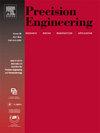结合机床内部信号和深度学习方法的单点金刚石车削表面粗糙度预测
IF 3.5
2区 工程技术
Q2 ENGINEERING, MANUFACTURING
Precision Engineering-Journal of the International Societies for Precision Engineering and Nanotechnology
Pub Date : 2025-02-27
DOI:10.1016/j.precisioneng.2025.02.026
引用次数: 0
摘要
提出了一种考虑刀具与工件相对振动和材料膨胀效应的单点金刚石车削(SPDT)表面粗糙度预测模型。在以往的预测模型中,通常在加工操作之前测量刀具与工件之间的相对振动(或刀具-工件的相对振动),并将其简化为多个稳定简谐运动的叠加,忽略了其在整个加工过程中的变化,从而导致重要细节的丢失。此外,很少有模型同时考虑刀具工作振动和材料性能的影响,这两者都对表面粗糙度有很大影响。在本研究中,开发了一种信号采集系统,用于采集机床内部信号,以准确反映切削过程中振动状态的变化。建立了动态体积形貌仿真模型,利用采集到的内部信号实现了过程中表面生成仿真。为了考虑材料性质的影响,构建了深度长短期记忆(LSTM)网络来估计材料膨胀效应引起的表面形貌变化。实验验证了所提出的表面粗糙度预测模型,结果表明,该模型能够稳定、准确地预测表面粗糙度,所有试验的相对预测误差均小于10%。此外,该模型的动态特性还提供了进行在线质量和异常监测任务的能力。本文章由计算机程序翻译,如有差异,请以英文原文为准。

Prediction of surface roughness in single-point diamond turning by combining machine tool internal signals and deep learning method
This paper presents a novel surface roughness prediction model for the single-point diamond turning (SPDT) process which takes into account the relative vibration between the cutting tool and workpiece as well as the material swelling effect. In previous prediction models, the relative vibration between the cutting tool and the workpiece (or the relative tool-work vibration) was commonly measured prior to the machining operation and simplified into a superposition of multiple steady simple harmonic motions, neglecting its variations throughout the machining process and resulting in the loss of significant details. Moreover, few models have simultaneously considered the impact of the relative tool-work vibration and material properties, both of which substantially influence surface roughness. In this study, a signal acquisition system is developed to collect the machine tool internal signals that can accurately reflect the varying vibration states during the cutting process. A dynamic volumetric topography simulation model is established to realize in-process surface generation simulation using the collected internal signals. To consider the influence of material properties, a deep Long Short-Term Memory (LSTM) network is built to estimate the changes in surface topography caused by the material swelling effect. Experiments are conducted to validate the proposed surface roughness prediction model, and the results demonstrate that it can stably and accurately predict surface roughness with relative prediction errors lower than 10 % for all test experiments. Moreover, the dynamic characteristic of the model also provides the capability for conducting online quality and anomaly monitoring tasks.
求助全文
通过发布文献求助,成功后即可免费获取论文全文。
去求助
来源期刊
CiteScore
7.40
自引率
5.60%
发文量
177
审稿时长
46 days
期刊介绍:
Precision Engineering - Journal of the International Societies for Precision Engineering and Nanotechnology is devoted to the multidisciplinary study and practice of high accuracy engineering, metrology, and manufacturing. The journal takes an integrated approach to all subjects related to research, design, manufacture, performance validation, and application of high precision machines, instruments, and components, including fundamental and applied research and development in manufacturing processes, fabrication technology, and advanced measurement science. The scope includes precision-engineered systems and supporting metrology over the full range of length scales, from atom-based nanotechnology and advanced lithographic technology to large-scale systems, including optical and radio telescopes and macrometrology.

 求助内容:
求助内容: 应助结果提醒方式:
应助结果提醒方式:


